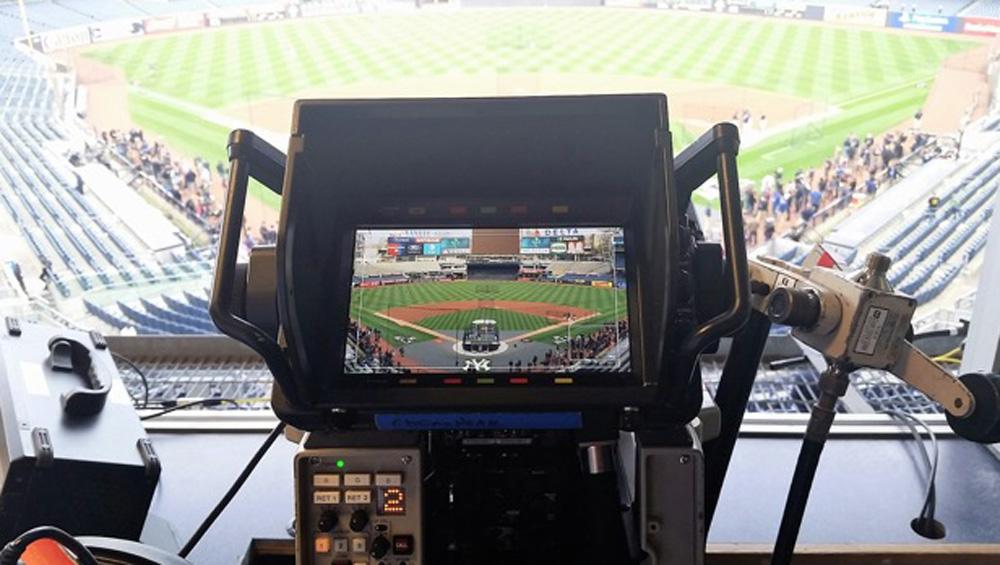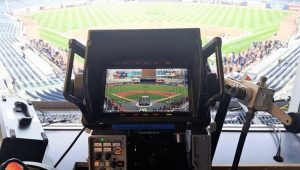
Fox, MLB, TBS Turn Up The Tech To 11

With the New York Yankees’ convincing 7-2 Wild Card victory over the Oakland Athletics last night, Fox, MLB Network and TBS are set to bring three rounds of post-season baseball this month to millions of TV viewers with state-of-the-art technical wizardry, including ubiquitous on-field audio, high-quality slo-mo from new perspectives, data-enhanced graphics and, possibly, player- and coach-mounted cameras.
And like last year, Fox will also be producing some of the games in 4K UltraHD for distribution by MPVDs like DirecTV.
Fox holds the rights to the National League Divisional Series, NL Championship Series and the World Series. Its FS1 cable network will carry the entire NLDS and half the NLCS, while the Fox broadcast network is slated to air the rest of the NLCS and World Series.
 Brad Cheney, Fox Sports VP of field operations and engineering, says the production will be the same for FS1 and the broadcast network. “The one thing we did two years ago is to elevate the whole package.”
Brad Cheney, Fox Sports VP of field operations and engineering, says the production will be the same for FS1 and the broadcast network. “The one thing we did two years ago is to elevate the whole package.”
The one difference is Fox will be adding a studio with staff to the World Series production for a pre-game show.
Fox will use two mobile production trucks for the NLDS, three for the NLCS and six for the World Series. The main mobile units will be Game Creek Video’s Yogi or NEP’s EN2, depending on the city.
According to Cheney, Fox is greatly expanding its use of high-frame-rate cameras for this year’s postseason after running tests at the 2018 All-Star Game and working with the technical team at Fox-owned RSN YES Network.
YES used high-frame-rate capability for all of its main game cameras for home games at Yankee Stadium. That means it could do at least 2x slo-mo replays from all 16 camera positions, with some capable of 6x and 8x slo-mo.
Following suit, Fox has almost doubled its number of high-frame-rate cameras for the 2018 playoffs, using a mix of Sony HDC-4300 1080p units that are capable of 2x or 6x operation and HDC-2500 series cameras that can do 2x slo-mo only (120 frames per second). That has allowed it to offer slo-mo replays from some new camera positions.
“A couple of years ago when the 6x cameras came out, you wouldn’t have put that in high home,” says Cheney. “But with the 2x, you can do it. So now we have six of those cameras in 2x mode, which has augmented our regular six 6x cameras and our two X-Mo Phantoms, which shoot at 2000 frames per second.”
Another technical innovation that Fox experimented with at the All-Star Game — and at press time was hoping to use this post-season — are compact “player cameras” mounted on bullpen catchers and base coaches “to provide another angle for everybody at home to see,” Cheney says.
Shots from a camera on the first-base coach might include close tag plays, or the coach waving a runner to go to second. Or the cameras might simply capture a coach greeting a player at first base.
“It adds more realism and intimacy to the event,” says Cheney. Whether such cameras are used will depend of getting the cooperation of the teams, he added.
Fox will be using a similar graphics package as last year’s playoff coverage, using tools developed by SMT (SportsMEDIA Technology) as well as Major League Baseball Advanced Media (MLBAM)’s Statcast. There have been a few refinements, says Cheney, “to make things easier to read and more precise.”
The Emmy Award-winning Statcast system, created by MLBAM, TrackMan and ChyronHego, now integrates Amazon Web Services cloud-based machine learning to help analyze MLB action.
Statcast uses a combination of Doppler radar, optical tracking, advanced graphics and statistical algorithms to show hitting metrics like the exit velocity of a home run ball leaving a bat and its launch angle, as well as pitching stats like spin rate and defensive metrics like catch probability.
MLBAM has also developed Pitchcast, a pitching analysis system which displays the strike zone and shows pitch trails and other strike zone graphics.
All of the networks use Statcast and PitchCast to varying degrees, though the branding on their onscreen graphics differs. (Editor’s note: SMT and MLBAM are currently involved in patent litigation over the Pitchcast technology.)
The “virtual strike zone” graphic, introduced by Fox in last year’s postseason, which will once again be used by Fox analyst and former ace pitcher John Smoltz.
“It gives him a better ability to break down pitching, showing where the ball goes and how it moves through the strike zone, and also why a pitch in a certain part of the zone, when it misses by a little bit, can really help the batter,” Cheney says .
Fox is expanding its use of IP interconnectivity by creating a cloud-based file-sharing system that will be used by its own staff as well as Turner’s, says Cheney. The file-share system uses Amazon AWS as the cloud platform and is based on a system Fox developed for last summer’s FIFA World Cup coverage. Cheney says that Turner and ESPN are already doing something similar for NBA coverage.
“It allows us to share clips in real-time fashion, and gives us access to what everybody is doing for the storyline of baseball, with much better replay options,” he says.
From a volume standpoint, Fox is going to push, on average, seven hours of content per game into the cloud, roughly double the average length 3.5-hour MLB game.
“It’s about 900 clips a game, averaging 30 seconds for each clip,” says Cheney. “Some are longer, some are shorter; it depends on the amount of super motion we’re using.”
Fox plans to produce four games in 4K during the NL Championship Series in a side-by-side model, where one truck will produce in 4K and another in the standard 720p HD. Camera feeds and graphics will be true native 4K; replays will be upconverted from HD as there are not enough 4K replay devices available.
“There will be two sets of technicians listening to the same producer and director,” Cheney explains.
Fox is currently producing one college football game each week in 4K, doing a full production in 4K and then downconverting it to 720p HD for all HD viewers.
“That’s our preferred method,” says Cheney. “But with the size of the post-season and the facilities available, side-by-side works.”
Last year the league gave the networks new latitude in placing additional microphones on the bases and around the infield, and that trend will continue this postseason for TBS, FS1 and MLB Network, which will be airing two NLDS games.
“It’s the same audio philosophy,” says Susan Stone, SVP of engineering and operations for MLB Network. “We want to get the sounds around the plate — the bat cracks and the ball in the glove.”
MLB Network’s two telecasts will be part of a week-long free promotion (Oct. 3-10) for cable and satellite subscribers that will temporarily increase its reach to almost 90 million homes.
In addition to those games, MLB Network will produce more than 175 hours of live coverage throughout the postseason, including interviews, game previews, highlights and in-studio analysis.
MLB Network will be sharing production facilities with Fox and using the same core mobile units to produce the NLDS games. But MLB Network will supplement Fox’s operation with 45 additional production personnel and its own “C” mobile unit equipped to support the Pitchcast and Statcast graphics as well as virtual signage applications.
MLB Network will expand on Fox’s array of slo-mo cameras with two Vision Research Phantom ultra-high-frame-rate cameras, located at the “low home” and third base positions. It will also be using “Front Row Cam,” which equipment rental vendor VER developed in conjunction with ESPN during the 2017 MLB season.
ESPN has exclusive rights to use the system for its Sunday Night Baseball telecasts but has given MLB Network permission to use it in the NLDS, says MLB’s Stone.
The “low-home” camera position provides a head-on shot of the pitcher staring in at the catcher and slo-mo images of the throws to home plate, a shot that went away when teams stopped making room for a camera behind home plate in favor of high-priced seats.
Front Row Cam, which sits flush against the wall behind home plate without obscuring any views, measures 16 by 32 inches and consists of a vertically-oriented robotic camera, wrapped in padding, that shoots at a robotically-controlled mirror that reflects the pitcher’s image. The mirror moves to give tilt functionality, and the camera rotates on its base to give pan functionality.
“We love that look, and we think [VER and ESPN] have done a great job innovating that,” says Stone.
MLB Network won’t be doing any file-sharing in the cloud but instead will be relying on its in-house asset management system, Diamond, which it shares with MLBAM.
The proprietary, server-based system, which links to EVS replays servers in the production trucks, is hosted at a data center in Secaucus, N.J., a few miles from MLB Network headquarters.
“It has everything we want, and everything lives in that system,” says Stone.
When it comes to moving content, MLB Network maintains an MPLS (Multiprotocol Label Switching) network with dual 10-gigabit-per-second fiber links (one AT&T, one CenturyLink) to every ballpark.
That has allowed MLB Network to easily expand into new offerings, such as producing 20 streaming games for Facebook this past season and launching coverage of individual teams’ batting practice.
The batting practice shows are done using a REMI (remote integration), also known as “at-home” production methodology, where a live sports broadcast is produced by backhauling the camera feeds via fiber or broadband connections to a remote studio instead of relying on a mobile truck onsite.
MLB Network uses the league’s existing ballpark camera infrastructure to capture batting practice and a director and other production staff in Secaucus then produce the show, switching between cameras, adding graphics and generating replays.
MLB Network first experimented with REMI production for its onsite coverage of the 2009 World Series at Yankees Stadium in New York. As fiber connectivity has only improved nationwide since then, the network has used the same scheme to produce its subsequent onsite World Series broadcasts.
“It’s a great model for us,” says Stone. “It’s cost-effective, and at the World Series it does help make things make more manageable.”
TBS will broadcast the American League Division Series, which includes a matchup between the last two AL pennant winners in the Cleveland Indians and the defending World Series champion Houston Astros, as well as the American League Championship Series.
Like last year, enhanced audio will be a major focus with base-mounted microphones being used for every AL postseason telecast.
TBS’ game coverage will also include StatCast and an expanded Pitch Cast strike zone overlay, which the network says will feature a new “four corners” look to be less obtrusive for fans.
TBS will provide live simulcast streaming on TBS.com and the Watch TBS app. Turner Sports will also provide fans with digital companion coverage via the B/R Live app, which will show each team’s batting practice before the TBS-broadcast games.
























Comments (0)